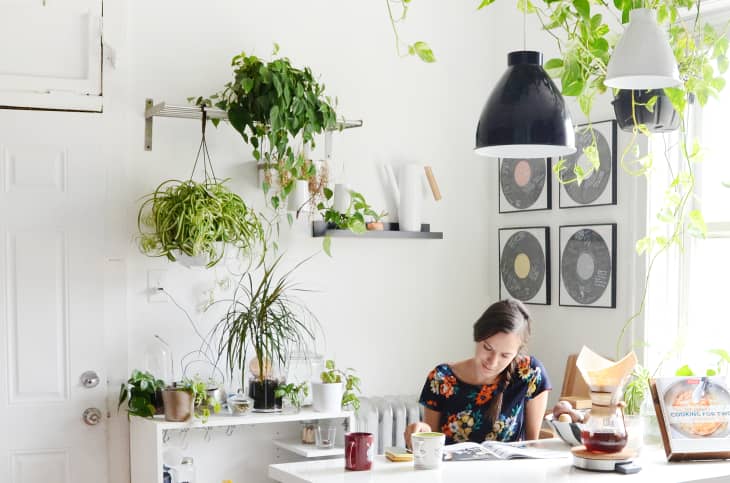Houseplant Help: How to Save a Plant Whose Leaves are Turning Yellow

If you’ve ever been a concerned plant owner, then you probably know that yellowing leaves are one of the first signs that your plant is distressed. But with possible root causes ranging from underwatering to overwatering to a pest problem, it can be hard to get to the bottom of your plant’s ailment. The next time you need to diagnose a sick houseplant, consider this your step-by-step guide.
Step 1: Check for “Moisture Stress”
If you notice your plant’s leaves turning yellow, get ready to play plant therapist and check for signs of stress. The most common plant stressor is too much or too little water. To check how much moisture your plant is getting, press a finger about an inch into the plant’s soil (don’t just test the surface of the soil, which tends to dry out the fastest).
The Diagnosis: If the soil is parched an inch below the surface, it’s likely your plant is thirsty. Get that plant a glass of water ASAP, and commit to watering it more regularly. If the soil feels damp an inch below the surface, your plant may be getting enough water, or it may be over-watered. Check for signs of root rot, such as a mildew-y smell. If you suspect that your plant is overwatered, adjust your watering schedule and consider transferring your plant to a container with better drainage so the roots won’t sit in a pool of water.
Step 2: Look for Unwelcome Critters
While under- and overwatering are the two most common reasons for yellowing leaves, if you’ve ruled them out as potential causes, a pest infestation may be to blame. Although difficult to see with the naked eye, mealybugs or spider mites may be provoking your plant.
The Diagnosis: If pests are present, it’s likely you’ll notice other signs of an invasion upon close inspection. Are there tiny holes on the leaves? This may indicate that spider mites are chomping on them. Do you spot a fluffy white wax on your plant? Mealybugs may be the culprit. To quell infestations, try rinsing off your plant, pruning the affected, wilting leaves, or spritzing the plant with store-bought insecticidal spray or neem oil.
Step 3: Let Them Soak Up the Sun
Another likely reason your plant’s leaves are turning yellow is that they’re starved for sunshine. If your apartment doesn’t get a lot of natural light, it may be time to book your plant’s next sun-bathing session.
The Diagnosis: If your plant is located in a shady corner, consider relocating it permanently to a sunny spot, or let it soak up the sun near a window for a couple hours. Watch the plant carefully to see how it deals with the big move, as some sensitive plants can have a hard time adjusting after a relocation. It may sounds obvious, but if your houseplant is stationed next to a window with blackout curtains you often forget to open, remember that even if you’re not home to enjoy the sunshine during the day, your plant is.
Step 4: Protect Them from Cold Drafts
Many varieties of houseplants are tropical, and predictably, aren’t big fans of cold weather and drafty homes. If you’re keeping your palm tree beside a drafty window, don’t be surprised if the leaves turn yellow.
The Diagnosis: Consider whether your plant may be catching a cold, and remember that drafts aren’t just possible during the winter, but an over-active air conditioner could also be the cause. Also keep in mind that the colder the environment, the less often your plant may need to be watered because the moisture in the soil won’t evaporate as quickly. A cold draft may not only be making your plant chilly, but also water-logged.
Step 5: Make Sure They’re Well-Fed
You may assume that your plant is getting all the nutrients it needs from the soil, but if the leaves are turning yellow, it may indicate a nutrient deficiency that’s interfering with photosynthesis.
The Diagnosis: If the older leaves on your plant are turning yellow and the new leaves are very light green, it could be a sign of a nitrogen deficiency. Look for plant food with this nutrient and follow the recommended feeding rate to avoid fertilizer burn. With just the right amount of fuel, your plant will look lush again in no time.
Feeling motivated to grow your indoor garden? Get inspired by these<a rel="noopener noreferrer" href="10%20urban%20jungles.%20</em></strong>%20</p>%0A%0A%0A<div%20id='jwppp-video-box-d04OdG50'%20class='jwppp-video-box'%20data-video='d04OdG50'%20style=" margin:>